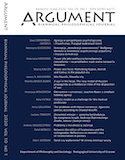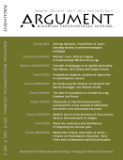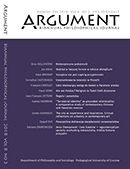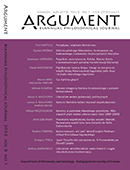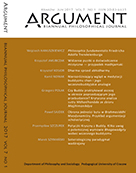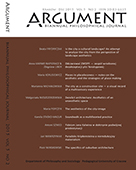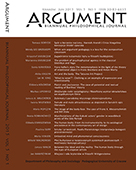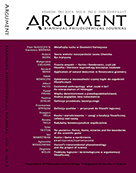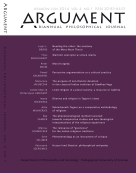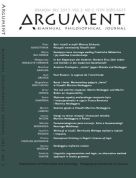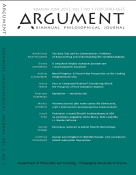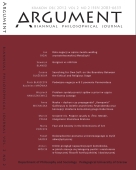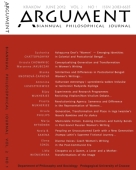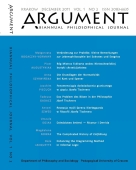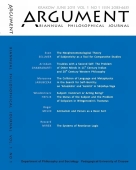e-ISSN 20841043
Kraków, December 2015, volume 5, number 2
SPIS TREŚCI

Temat wiodący numeru:
Estetyka miasta
red. Maria Popczyk

Od redakcji
Introduction to the issue (Maria POPCZYK) (329-335)
Artykuły i rozprawy
Piotr WINSKOWSKI, The specifics of suburban architecture (337-358)
Abstrakt
The fundamental differences between the suburbs and the city centre that I would like to point out concern the pace of life and the intensity of urban development. Certainly, these differences are not absolute but are rather relative, as they are defined in relation to the surrounding neighbourhood that serves as a reference for self‑determination. A suburb has some small‑town traits, but its close location to the city prevents it from becoming a local centre. The same concerns the architecture whose intensity is, after all, a consequence of the increasing intensity in other aspects of life, the differentiationof sources of people’s income, the demand for services, trade contacts, etc. Its incompleteness, imperfection, slower pace and focus on anunattained and unattainable ideal can make one see in the suburb as a theoretically extremely promising area. Indeed, its promise lies in this aspect of failure, incompleteness and fragmentation — which is long lasting and relatively permanent. Many traits of suburban architecture are conservative; whereas others, such as its impermanence and improvisational qualities, are experimental and are characterised by an almost guerrilla‑like aspect. However, present‑day advanced postmodern thinking at times achieves an ability to take contradictory spatial, visual, artistic and functional characteristics and, through a theoretical analysis, make them into a complex ‘difficult whole’. Here, the combination itself is probably not so much harmonious but rather contains certain internal tensions, imbalances and longings of one opposite towards another. Anyway, this combination does take place and — in line with the direction of many diagnoses of contemporaneity — instead of creating abstract constructs, we must register the facts and try to conceptualise them.
Słowa kluczowe: suburb architecture; suburb life pace; city centre space; suburb inside the city centre; potential of the suburb
Beata FRYDRYCZAK, Is the city a cultural landscape? An attempt to analyze the city from the perspective of landscape aesthetics (359-371)
Abstrakt
This paper sets out to interpret the phrase ‘the city landscape’. Beginning with landscape aesthetics based on two categories — the picturesque and the sublime — the author attempts todemonstrate that a city can be interpreted in terms of a cultural landscape. This necessitates a re‑interpretation of the category of the sublime, whereby, through references to Edmund Burke, Theodor W. Adorno and Arnold Berleant, the sublime assumes the nature of a category which determines the existential situation of a person in the world. Here, the sublime provides people with an impulse to undertake efforts to fashion their surroundings and forge the essence of the living world. As such, the sublime also becomes a category that promotes social activities aimed at improving the quality of life in a city, such as the activities of ‘urban gardeners’.
Słowa kluczowe: the picturesque; the sublime; nature; the city landscape; experience; engagement; the surroundings; landscape park
Maria POPCZYK, The aesthetics of the city–image (373-386)
Abstrakt
In this paper, I will examine the aesthetic implications of the theories which regard the city as an image. Essentially, I will focus on the positions of the two practitioners, Kevin Lynch and Juhani Pallasmaa, who are an urban planner and an architect respectively, in order to confront two very different approaches to the ‘image’; namely, an empirical approach and a phenomenological one. I am interested in what the city becomes when it is looked upon as an image and I will reflect on the experiences of the city‑image in its various aspects. The aim of this discussion is an attempt to outline certain research areas for exploring the aesthetics of the city centred on the image, with the practitioners’ theories enabling us to widen the scope of this exploration.
Słowa kluczowe: image; city; urban aesthetics; Kevin Lynch; Juhani Pallasmaa
Małgorzata NIESZCZERZEWSKA, Derelict architecture: Aesthetics of an unaesthetic space (387-397)
Abstrakt
The main focus of this article is the question of the aesthetics of an unaesthetic ruined space.The author also pays particular attention to the ambivalence that exists in contemporary derelict architecture, referred to as ‘modern ruins’, and tries to show that such locations can be viewed as an ‘in‑between’ space.
Słowa kluczowe: derelict architecture; ruinophilia; formativity; work of art; time; temporality
Maria KORUSIEWICZ, Places in placelessness — notes on the aesthetic and the strategies of place–making (399-413)
Abstrakt
The paper discusses the aesthetic aspects of place‑making practices in the urban environment of Western metropoles that are struggling with the progressive undifferentiation of their space and the weakening of communal and personal bonds. The paper starts by describing the general characteristics of an urban environment as distinct from the traditional vision of a city as a well‑structured entity, and in relation to formal and informal aesthetics and participatory design ideas. The author then focuses on two contrary but complementary tactics for translating a space into a positively evaluated p l a ce: by dome ticating it through introducing nature into an urbanscape; and by accentuating its alienness with the example of the urban exploration movement. The growing popularity of the latter is presented in relation to the discourses related to the decline of cities and the romantic endeavours for reaching into the realm of the unknown or the uncanny in order to rediscover and enrich the unique identity of a place. The paper ends with conclusions that present the necessity for the cultivation of a multidimensional aesthetic awareness and an aesthetic engagement as a crucial issue in the complex task of endowing places with a density of meaning.
Słowa kluczowe: domestication; exoticisation; urban exploration; aesthetic engagement
Marianna MICHAŁOWSKA, The city as a construction site — a visual record of a multisensory experience (415-438)
Abstrakt
In this article, I consider the reception of images that are present in a city space. I focus on the juxtaposition of computer‑generated images covering fences surrounding construction sites and the real spaces which they screen from view. I postulate that a visual experience is dependent on input from the other human senses. While looking at objects, we are not only standing in front of them but are being influenced by them. Seeing does not leave a physical trace on the object; instead the interference is more subtle — it influences the way in which we perceive space. Following in the footsteps of Sarah Pink, Michael Taussig and William J. T. Mitchell, I show that seeing (to paraphrase the title of an article by the last of the above mentioned scholars) is a cultural practice. The last part of the article presents a visual essay as a method that can contribute to cultural urban studies. I give as an example of such a method a photo‑essay about chosen construction sites in Poznań, which I photographed between December 2014 and June 2015.
Słowa kluczowe: visual essay; vision; visuality; architectural photography; computer‑generated images
Kamila STAŚKO-MAZUR, Soundwalk as a multifaceted practice (439-455)
Abstrakt
The soundwalk was invented as part of the initiatives undertaken by the World Soundscape Project group with an acoustic ecology profile, which emphasised the noise pollution that exists in people’s sonic environment and the need to reacquire our ‘lost skill’ of conscious listening. Initially, the practice of soundwalking was used as a method allowing us to ‘hone our hearing’ (to boost our sonological competence), to show the human condition with respect to modern reality. Soon, the soundwalk became an inspiration for many artistic undertakings that made use of the sonic properties of the environment and employed various listening strategies. This article is designed to present the idea of soundwalking since its theory and practices began to form. By presenting selected works by Hildegard Westerkamp, I intend to show the motivations behind the practice of soundwalking, which encompass the complex issues of perceiving and assessing city sounds. I refer these to Tim Ingold’s proposition to understand sound as a medium of experience. Soundwalking, as a practice of conscious listening by focusing attention on aural sensations, paradoxically seems to reveal the multi‑sensory structure of our relationship with the world, and the mediatory function of sound in our experience of being‑in‑the‑world.
Słowa kluczowe: soundwalk; sonic environment; soundscape; mediation; perception
* * *
Jan WAWRZYNIAK, Paradoks Kripkensteina a nieredukcyjny materializm (457-475)
Abstrakt
Kripkenstein’s paradox and nonreductive materialism: The main aim of this article is to pose and consider the following question: Does the reasoning that led to Kripkenstein’s sceptical paradox undermine all versions of materialism, including nonreductive materialism? First, I present other versions of materialism in the philosophy of mind. Then I point out that, according to nonreductive materialists, one can neither define mental properties in terms of physical properties nor derive psycho‑physical laws from the laws of physics. The presently‑understood thesis of materialism is confined by the following claim: the same distribution of physical properties entails the same distribution of mental properties. In other words, the mental properties supervene upon physical properties. This account then leads to the following formulation of the main question: Assuming that Kripkenstein is right, do mental properties supervene upon physical properties? Taking into account that answering this question requires a discussion of the notions of supervenience and Kripkenstein’s paradox, I devote two parts of my paper to these topics. The conclusion which I reach is as follows: If the reasoning that led to Kripkenstein’s paradox is correct, mental properties can only globally supervene upon physical properties, and consequently no version of materialism can be empirically justified.
Słowa kluczowe: Donald Davidson; Saul Kripke; mental properties; anomalous monism; supervenience
Antoni SZWED, Fideizm Jana Kalwina w doktrynie podwójnej predestynacji (477-500)
Abstrakt
John Calvin’s fideism in the doctrine of double predestination: Fideism, as a philosophical and theological view, is defined in various manners. Sometimes it is defined as the priority of faith over accounts of all kinds of cognition based on human reason. The Geneva reformer John Calvin (1509–1564) was a fideist, and he simultaneously admired Saint Augustine — traces of that admiration can be found very easy in the chief Calvin’s work Institutio christianae religionis. However, this does not mean that he shared Augustinian views on faith‑reason relations. John Calvin adopted late‑Augustinian interests, and was especially concerned with the issue of predestination. The Geneva reformer was the author of the double predestination doctrine. The chief claim of this doctrine is that: God intended one part of humanity for salvation; and the other one for damnation. This conclusion was supported with numerous quotations from the Old and the New Testament, and followed from the accepted exegetic principle that all words of the Holy Scripture are to be understood literally. Calvin also acted selectively and did not take into account other passages of the Bible contrary to them in sense. These different, even contradictory words and quotations create an incoherent image of God, which Calvin left unexplained as one of God’s mysteries. According to this image, God is a petulant despot, who by his irrational will treats people with unequal measure. God has settled a priori who would be saved and who would be damned, so the will of concrete man to act well or badly is without importance. In consequence, God is responsible for the evil and sins committed by people. Calvin’s God is unfair because he is merciful for one man, but not for other one. In approving a voluntaristic image of God, Calvin started becoming, particularly in the doctrine of double predestination, an extreme fideist, much more than his master Augustine. However, in later decades (especially in the seventeenth century), Calvin’s version of Christianity gaverise a rebellion against the double predestination doctrine, first in the ranks of the Dutch Calvinistic theologians (Armenians), and later in the circles of the English philosophers (Cambridge Platonics). In the end, Calvinism became a compromised Christianity and essentially contributed to the development of deism and atheism in Western European Countries in the eighteenth century.
Słowa kluczowe: fideism; double predestination; depiction of God; determination of human morality; calvinistic Christianity
Polemiki
Anna KARNAT-NAPIERACZ, Zbigniew LIBER, Odczarować ZWDPF – zespół wrodzonej dezakceptacji płci fenotypowej (501-518)
Abstrakt
Disenchanting Inborn Gender Identity Disorder Syndrome: Reflections on Małgorzata Bieńkowska’s book Transsexualism in Poland. The individual and social dimension of crossing over the binary system of sex (2012): This article reflects on an in‑depth reading of a publication exploring the question of transsexualism and transsexuals in Poland, as well as the experiences resulting from the medical care of such individuals. The first part of the text is a supplement with essential information from the medical field, which to a large degree is uncovered in the book under review. The second part presents critical comments relating to the book’s contents both in terms of the information it contains (on a theoretical level) and equally in terms of its research (on an empirical level). In the conclusion, both the overall positive aspects of the publication as well as its weaker points are summed up in general terms.
Słowa kluczowe: biological sex; perceived gender; brain sex; somatic sex; phenotype sex; sexual identification; gender recognition
Recenzje i noty książkowe
Jakub Gomułka, Karol Tarnowski i Adam Workowski (Red.): Fenomenologia polska a chrześcijaństwo. Rec. Wiesława SAJDEK (519-524)
Słowa kluczowe
filozofia polska, filozofia chrześcijańska, fenomenologia a religia
David H. Newman: Cień Hipokratesa. Tajemnice Domu Medycyny. Rec. Anna KARNAT-NAPIERACZ (525-531)
Słowa kluczowe
kultura medycyny, urynkowienie usług medycznych, relacja lekarz – pacjent, społeczna rola lekarza
Barbara Skarga: Przeszłość i interpretacje. Z warsztatu historyka filozofii. Rec. Aleksandra WĘGRECKA (533-540)
Słowa kluczowe
filozofia historii, historia filozofii, interpretacja przeszłości
Daniel Dennett i Alvin Plantinga, Nauka i religia. Czy można je pogodzić? Rec. Magdalena KŁECZEK (541-542)
Słowa kluczowe
filozofia nauki, filozofia religii, filozofia umysłu
Autorzy tomu
Pełny tekst (543-546)


